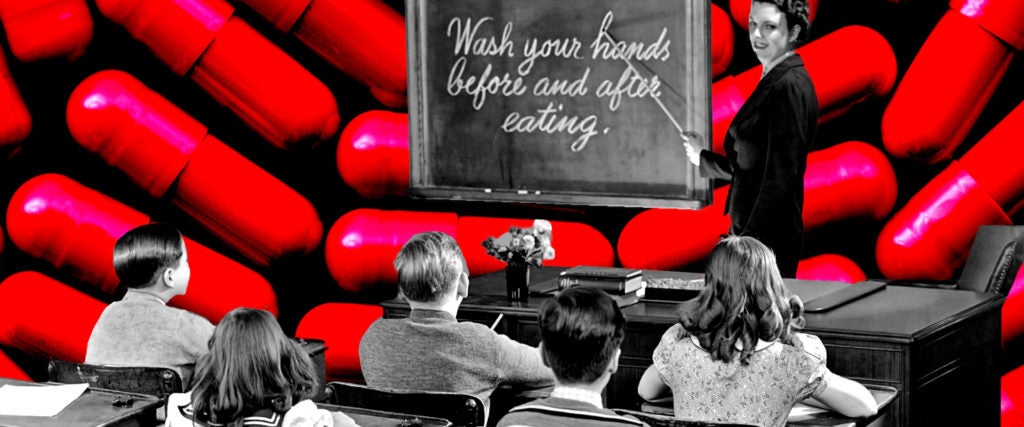Olivia, a 34-year-old teacher in Kentucky, had the “great displeasure” of watching one of her 14-year-old students become radicalized online. “[He went] from a sweet kid to a year later tweeting that if homosexuals weren’t willing to change their ways, they should be killed,” she says. “He then started tweeting about Black Lives Matter, immigrants, liberals, feminism and anything else he could get his hands on. This was a kid that was generally kind and quiet, but he began following far right figures on Twitter and the rest is history.”
Jennifer, a 30-year-old teacher in Arizona, had a similar experience. She had one student in the third grade who was a flat-earther, and he’d raise this and other conspiracy theories about vaccines and the Illuminati at school. “He’d tell my class the earth is flat during our gravity lessons, and it was so difficult to explain to him that it can’t be true,” she says. “He’d repeatedly tell me that I’m wrong and try to derail the class. He questioned me a lot in front of the kids as if he was testing my authority as a teacher.” He continued his mission outside of the classroom, too, sharing conspiracy videos from YouTube with other students during recess.
The prospect of red-pilling, in which a person becomes radicalized by far-right spaces online, has attracted a lot of media attention in the Trump era, amid rising concern about political polarization and the ascent of far-right figures on platforms like YouTube. Often, the entry point for awkward or disgruntled men is the “manosphere” — a misogynistic online subculture that includes incels, men’s rights activists, pick-up artists and Men Going Their Own Way — but this tends to be a gateway to other far-right talking points.
“Grievances related to lack of sexual and romantic partners are located in the same spaces as right-wing propaganda around the refugee crisis and trans issues,” Annie Kelly, a PhD student at the University of East Anglia who researches the impact of digital culture on the far right, told MEL in January 2019. “When they’re reinforced in these groups, as well as by mainstream media outlets on Facebook and YouTube, people end up buying into some of the maxims without realizing it.”
Generally, though, the focus tends to be on an adult individual who has been radicalized or the impact on their partners or parents. There’s been less attention paid to the unique position of teachers who find themselves faced with radicalizing students, even though they’re often the first witnesses of the early warning signs of red-pilling among a younger cohort. “I have totally noticed the radicalization of students with MRA stuff,” says Kira-Lynn Ferderber, a sexual violence prevention educator in Florida. “I teach kids of all ages but I notice it most in middle school and high school boys, and it’s getting worse and worse.”
Often, it’s hard for teachers to tell whether a student is being truly red-pilled in the sense that they’re being radicalized online, or whether they’re parroting views that they’ve grown up with in their conservative households. Tessa, a 29-year-old in the Midwest who teaches 14- to 18-year-olds at a private school for students with learning impairments, says that while many of her students “simply take on the talking points and politics of their conservative parents,” this can make them especially ripe targets for full-blown radicalization and infatuation with far-right figures. “A few started listening to Joe Rogan’s podcast, which led to them reading Jordan Peterson’s books,” she says. “I think that Joe Rogan’s ideology is the biggest threat to critical thinking in the last decade.”
There are some obvious warning signs that a student is being red-pilled, though, like when they have a sudden and noticeable rightward shift in their views; when they specifically mention figures like Ben Shapiro and Peterson, who Olivia says her student “loved”; and when they use language that makes the online influence obvious, like “Chad” and “cuck.”
“There’s always been boys who ask, ‘Don’t girls just lie [about rape], though?,’ and we do want to take those questions seriously,” Ferderber says. “But increasingly they’re using language that sounds straight from Reddit, and they aren’t satisfied with an answer or a statistic I can cite. These are teenage boys who have MRA talking points. They’re extremely fixated on the idea of false accusations and they talk a lot about women getting a lot of money by accusing men of rape, but when pressed, they don’t really know how that would happen.”
When teachers notice the warning signs of radicalization, difficult questions arise: Where is the line between shutting down these arguments and allowing kids to explore new ideas? And when is the right moment to intervene?
Jacob, a 28-year-old teacher in Texas, says that this can be a very delicate balance. “I would never want to ‘convert’ someone to being liberal, because you shouldn’t be converting anybody to political ideologies,” he says. Nonetheless, he’s had success convincing even the “alt-right kids you can spot a mile away” to consider alternative points of view. “I’ll tell my students that it’s always better to err on the side of compassion than aggression, that the root of our problems is fear, and that getting to understand how other people live makes your life better,” he explains. “I tell the kids that I don’t care what they think, as long as they think for themselves.”
The trouble, Jacob says, is that when he discusses ideas with his students that pose even the mildest challenge to the conservative orthodoxy that prevails in his region, he faces backlash from parents. Once, he was reported by a parent for teaching students the secular Common Era notation system, and another time he got phone calls for telling his class about religions other than Christianity. “I just informed them, that’s it,” he says. “It’s like just exposing them to knowledge is threatening, and even when I toe the line, I still get in trouble.” He says it becomes a difficult game of bothsidesism, in which secular and scientific ideas are treated as some kind of left-wing radicalization on his part. “I’ve had to accept that from time to time I will teach tolerance, and it will be seen as brainwashing,” he tells me.
Tessa says that students often take on this conspiratorial mindset, too. “A lot of the conspiracies these students believe, like superior white genetics or that being LGBTQ+ is a mental illness, take root for them specifically because they think it’s a hidden truth I’m keeping from them as a teacher,” she explains. “They think I’m brainwashed by liberal narratives and that I’m compelled to lie to them.”
Jacob and Tessa’s experiences seem to be especially typical for teachers based in areas where deep conservatism is the norm. Here, the problem of students radicalizing online is often compounded at a social and institutional level, with far-right views being encouraged by parents and even other teachers. Jennifer’s flat-earther student transferred to her class in the middle of the year, so she wasn’t sure how quickly the radicalization had taken place. But after he was so disruptive during lessons that she ended up scheduling a meeting with his father, it became apparent that both he and the internet had a role to play.
“His dad just brushed [my concerns] off and implied that I was teaching the wrong things and trying to indoctrinate his son with my ‘liberal agenda,’” she explains. “I learned that he didn’t regard education as something worthwhile because he said he can teach his kid better with the videos that are on YouTube.”
Another problem when students are red-pilled is that they then attempt to convert other classmates. Red-pilled students become highly argumentative and confrontational during lessons to sway the class toward their ideas, which puts teachers in a bind. On one hand, they want to encourage the exploration of ideas in the classroom, but on the other, they don’t want class time to be endlessly derailed with debates about long-settled science and ethical norms, like racism being bad and LGBTQ+ people deserving rights.
“It’s hard because if I disregard [the manosphere students’ questions], I sometimes feel like it makes other students think, ‘Huh, she doesn’t have a good answer for that, it must be true!’” Ferderber explains. “So it doesn’t work to say, ‘I won’t dignify that with a response,’ but if you go down the rabbit hole with them, is it serving the needs of the other students?”
Of course, teachers are human too, and the emotional impact of being constantly challenged in the classroom can take a toll. “It was so frustrating,” Jennifer says about her flat-earth student perpetually derailing the classroom with his conspiracies. “He literally made me feel like I was a fraud, and it didn’t help that I was a new teacher at the time. When he’d tell me I was wrong and that these are the ‘alternative facts,’ I could feel my class lose their trust in me. It was a crazy power struggle for sure.”
It can also be devastating for teachers to realize that, despite their best efforts, some of their students might end up holding hateful beliefs long term, and many of them take it personally. “My biggest worry is that they’ll be stuck in their thinking forever, and that they’ll join the Proud Boys or something,” Tessa says. “I feel like I should be able to do a better job at teaching critical-thinking skills and they should have enough trust in me to believe that I’m telling them the truth.”
“Honestly,” she adds, “it makes me feel like I’ve failed at my job.”

